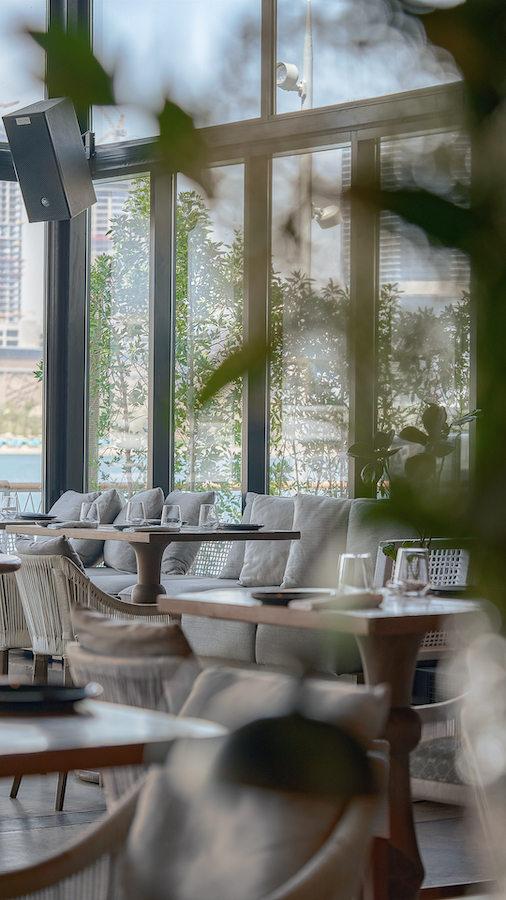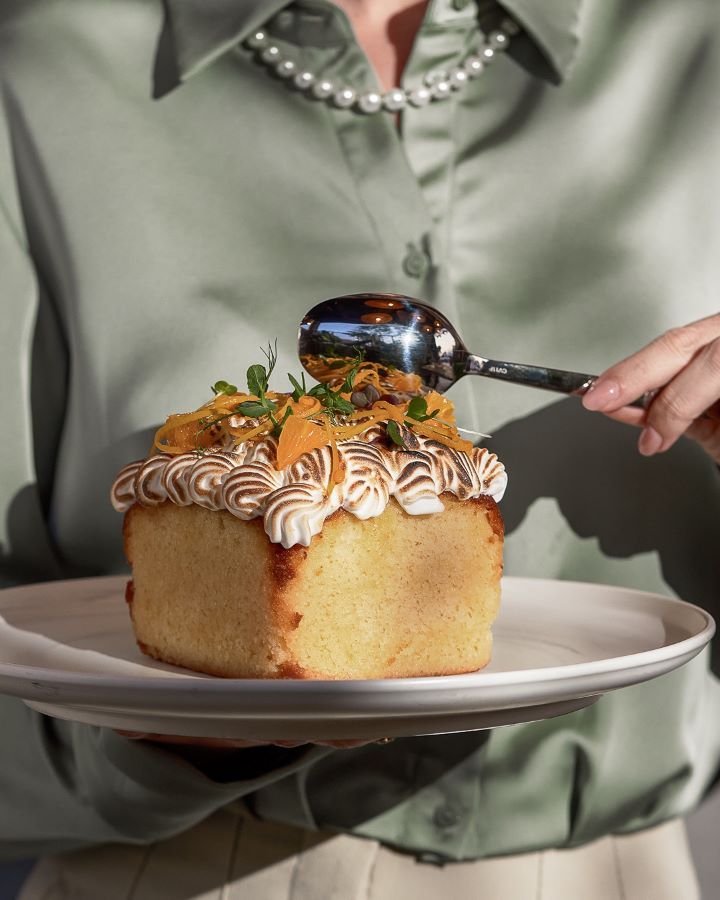Recipes for success: Chef Hadi Saroufim offers tips, shares an orange cake recipe
DUBAI: Hadi Saroufim, executive chef at Beirut-import Bar Du Port in Dubai, has been cooking since the age of 10, but he really fell in love with the culinary world once he started training in professional kitchens.
“The more I worked in the industry, the more I liked it. I feel lucky to do what I do – it just feels good,” he tells Arab News.
“One of my earliest culinary memories is modernizing a traditional Lebanese dish, kibbeh, from my village, Zgharta, in Lebanon. I turned it into a kibbeh roll with frozen yogurt, cucumber jelly and dry ice,” he says.

Bar Du Port. (Provided)
His favorite dish on the Bar Du Port menu is grilled octopus with dried chorizo, tomato tartare and smoked bell pepper coulis. “It uses simple ingredients but packs a punch,” he says. “This dish captures the essence of Mediterranean cuisine – fresh, bold and delicious.”
Here, Saroufim discusses burnt onions, annoying customer habits and the magic of vinegar.
When you first started, what was the most common mistake you made?
I often burned the onion and garlic during the preparation. In a professional kitchen, even if you are assigned to a certain section, you have to multitask and work under strict time constraints. The pressure to juggle various tasks at once can be overwhelming, especially for a new chef. Balancing the preparation of different components while keeping an eye on cooking times and techniques is a skill that takes time to develop. Those first few days were tough, but essential in learning how to manage everything.
What is the best advice for amateurs?
Always use the best fresh produce available. Quality ingredients can elevate a dish from ordinary to extraordinary. When you start with fresh, state-of-the-art produce, the natural flavors shine through. I have always admired the way chef Alain Ducasse emphasizes “naturalness” in his cuisine, focusing on the purity of the ingredients and letting their natural qualities speak for themselves. This philosophy also influenced my approach. Whether you're cooking a simple meal or an elaborate dish, the quality of your ingredients will always make a significant difference.

Thinly sliced yellowtail with burnt orange, passion fruit sauce. (Provided)
What ingredient can instantly improve any dish?
Vinegar, such as Xeres vinegar, instantly enhances any dish by adding a burst of flavor. Just a splash can lift the dish and bring out its best qualities, making it a must-have in any kitchen. I recommend it especially for risotto or salad dressing.
When you go out to eat, do you find yourself criticizing the food?
I definitely pay attention to food, but I try not to be too critical. One thing I often notice is the overuse of sauces. While sauces can enhance a dish, too much can overpower the main products and mask the natural flavors.
What is your favorite cuisine?
I especially like French and Japanese cuisine. I also admire the craftsmanship behind quality beef dishes such as Nobu's carpaccio, which inspires our own menu innovations.

Green lentil salad with rainbow cherry tomatoes, pomegranate and sumac dressing with yogurt. (Provided)
What customer behavior or request annoys you the most?
I love to innovate and be creative – it's all part of the craft. For example, our mashed avocado has a unique twist on a traditional guacamole recipe, and that once sparked a “friendly debate” with a guest about its preparation. While I always value guest feedback, it can be annoying when customers insist that dishes match their home recipes exactly, leaving little room for creativity.
What is your favorite dish to cook?
I am passionate about cooking fish because of its delicate nature and the precision it requires. Getting the timing right is crucial to retain its freshness and flavors. One dish that I particularly like to prepare is sea bass with butterflies. I love how simple yet elegant it is – seasoned with lemon juice, olive oil, salt and pepper and served with a refreshing zucchini tartare. It's a dish that showcases the beauty of fresh ingredients and allows me to express my creativity.

Burrata with kalamata olives, aged tomatoes, grilled zucchini and basil pesto. (Provided)
What is the most difficult dish for you to get right?
One of the most challenging dishes for me is the traditional French foie gras terrine – a classic of French cuisine. It requires meticulous technique, especially in the correct layering of the foie gras. Accuracy is key; a slight misstep can cause the layers to mix, compromising both the texture and presentation of the dish. Mastering terrine requires careful attention to detail and a deep understanding of ingredients, making it technically demanding but very rewarding.
As a head chef, how are you? do you shout a lot Or are you more relaxed?
My focus is on keeping the kitchen calm and organized. On our busiest nights, we can serve up to 1,200 covers in our relatively small kitchen, so it's important that everyone follows the rules. With a team of 15, discipline is crucial, but I avoid yelling because it's counterproductive.
Chef Hadi's Orange Cake Recipe

(Provided)
INGREDIENTS
For the orange cake:
340 g eggs; 470 g of sugar; 360g flour; 10 g of baking powder; 230 ml of cream for the whipped cream; 160g butter (melted); 70 g of orange juice; 7 g of orange peel
For the orange syrup:
60 g of orange juice; 30 g of water; 30 g of sugar
For the meringue:
3 egg whites (100g); 200 g of sugar
Additional:
50 g of oranges
INSTRUCTIONS
(Note: a bain-marie is required)
For the orange cake:
1. Preheat the oven to 160C.
2. In a bowl, combine the sugar and orange zest. Add eggs and beat well.
3. Add the orange juice and whipping cream. Mix well.
4. Sift the flour and baking powder. Mix until no lumps form.
5. Add the melted butter and mix well.
6. Pour the batter into a cake pan. Draw a straight line of melted butter on top.
7. Bake for 55 minutes.
8. Remove from the oven and pour the orange syrup over the cake. Let it cool down.
For the orange syrup:
1. In a small saucepan over very low heat, combine the orange juice, water and sugar.
2. Bring to a boil, stirring until the sugar dissolves.
3. Remove from heat.
For the meringue:
1. In a bain-marie, heat the egg whites to 65C.
2. Transfer the egg whites to a mixer.
3. Gradually add the sugar while mixing until stiff peaks form.
Assembly:
1. Once the cake has cooled and absorbed the syrup, serve the slices with a dollop of meringue and (optionally) garnish with fresh orange slices and a scoop of orange ice cream.
